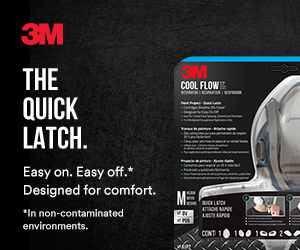 Jason Lunn is a 3M senior application engineer for safety and electrical products. He oversees the training and educational aspect of a wide variety of safety products, including respirators. Here’s a common question he hears about choosing respirators from both painting professionals and DIYers.
Jason Lunn is a 3M senior application engineer for safety and electrical products. He oversees the training and educational aspect of a wide variety of safety products, including respirators. Here’s a common question he hears about choosing respirators from both painting professionals and DIYers.
Q: There are many different types of respirators. How do I know which one is right for my job?
A: To start, I like to clarify the difference between disposable and reusable respirators. Disposable respirators shouldn’t be thought of as lower quality. They provide filtration against particles, such as solid dusts and liquid mists and, typically, are inexpensive and maintenance-free. In addition, some people may find them to be more comfortable to wear than reusable respirators because of their lighter construction.
Reusable respirators can filter against a variety of particles, gases and/or vapors, depending on the type of cartridge and/or filter being used. One of the main advantages for using these respirators is the wide range of cartridge and filter combinations available to protect against different types of airborne contaminants. In addition, reusable respirators may offer a degree of face/eye protection, depending on the models selected. While the initial expense of the respirator may be higher, the facepiece can be cleaned and reused, so the ongoing expenses are just the cartridges and filters.
Assessing the situation
Before choosing a respirator, it is important to conduct an exposure assessment to better understand exactly what types of gases, vapors and/or airborne hazards you may be exposed to. There are several methods to determine exposure levels; visit OSHA’s website to learn more.
When dealing with gas or vapor exposures exceeding OSHA’s permissible exposure limits (PELs), select a reusable respirator with the appropriate chemical cartridge for the hazard of concern. Cartridges contain treated carbon to help reduce exposure to a variety of different chemical types, depending on the NIOSH (National Institute for Occupational Safety and Health) approval rating. The chemical cartridges for reusable respirators are color-coded to help you remember which ones apply to what types of exposure.
If your exposure contains chemicals as well as particulates (such as paint spraying), some cartridges allow you to add a particulate pre-filter, so you can help filter out both particulates and gases/vapors. The benefit of having separate pre-filters is the fact that they can be changed independently of the chemical cartridges.
If your only exposure is a particulate hazard, consider a reusable respirator with a particulate filter or even a disposable respirator. When you hear the term ‘disposable respirator,’ think: protection against particle exposures, not chemical exposures. Some disposable respirators do offer a layer of carbon in the media to help reduce exposure to some nuisance odors, which are exposures below the PEL that some users might find unpleasant.
The right fit is key
It’s a common belief that simply wearing a respirator will help protect you, but in reality, the seal between the respirator and your face is critical to help protect your lungs. Follow the manufacturer’s user instructions that come with your respirator to ensure you’re using the product correctly and have a proper seal to your face. In the U.S., occupational workers need to be fit tested as part of a proper respiratory protection program, per OSHA’s 29 CFR 1910.134.
More is not always better
There’s also a misconception that more protection is always better. More protection typically adds cost, but make sure it is actually needed and would add a benefit for your situation as well.
For example, a painter using a half facepiece reusable respirator for spraying paint has many cartridges to choose from, but a cartridge that is NIOSH-approved for certain organic vapors is typically what is required. Choosing a multi-gas cartridge that is NIOSH approved for many different chemical types will cost more money, but doesn’t provide more protection for organic vapors; it offers an equivalent level of protection for organic vapors. The difference is that it also offers protection for other chemical types, but they are chemicals most painters likely won’t encounter when using common paint products.
Choosing an appropriate cartridge for the hazards present or the right disposable respirator for the job may take some research, but it’s well worth your time to protect yourself from dangerous exposures. To learn more about respirator selection and the different types of hazards you may encounter on the job, visit the 3M Center for Respiratory Protection.




